|
|
 |
|
|
Operation Hubertus - Part One
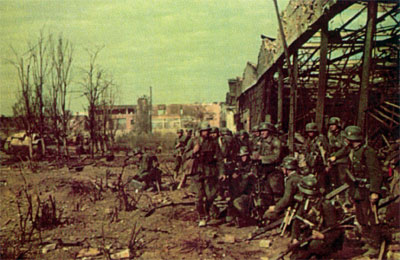 |
OPERATION HUBERTUS - PART ONE
Operation Hubertus – Ljudnikov's Last Stand in Stalingrad
By Wolf Höpper
Foreword
Most of the time, when a student of military history stumbles across a subject, he is not aware of the significance of the information he has just read.
|
|
Back in my younger years, I stumbled across a
magazine-sized publication named “Sonderheft II. Weltkrieg – Pioniere”
(lit. Special issue WWII - pioneers). I was hooked, since it featured
an in-depth (from my point of view back then) history of the German
combat engineers in WWII, and in it a special operation in a well-known
city was “detailed”.
In most publications about the battle of Stalingrad the different small scale combats and actions are covered only with slim, often too personalised, chapters. The reader usually gets a good feeling about the vicious, humanity defying fights that took place. This should not minimise the suffering of anybody who was involved directly or indirectly. However, on the historical side, the reader most often doesn´t get enough information about specific parts of the battle.
|
The intention of this article is to flesh out the detail of the operations of the German pioneers in Stalingrad.
The last offensive efforts of the German 6th Army to conquer Stalingrad between 11 and 19 November 1942 are mostly covered within two or three sentences in books that are at average 250 pages long! Most of the time no details about this time period can be found at all in many, often highly acclaimed, publications by well-known historians. Even a highly praised German TV historian (I
don’t want to name him for fear of reprisals), states only 4 sentences
about this subject in one of his best sellers.
|
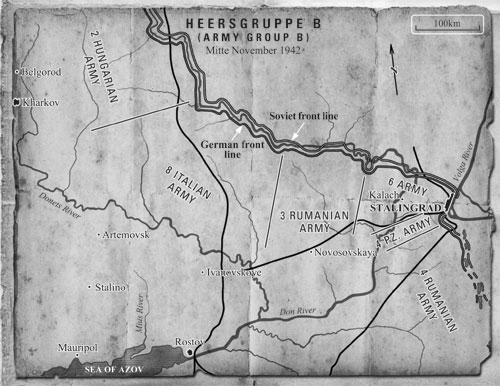 |
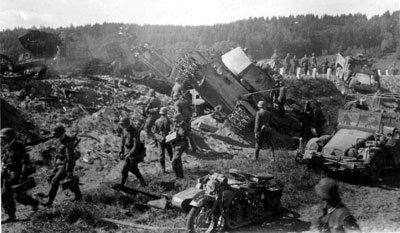 |
I. Prologue
On 8 November 1942 the commander-in-chief of Germany announced his plans to Germany for an offensive to take the last part of Stalingrad.
“I wanted to come to the Volga at a specific location at a specific city. By chance it carries the name of Stalin himself. So don’t think I marched there for this reason – it could carry another name – but because there is a very important goal... this goal I wanted to take – and you know – we are very modest, we have it already.
|
|
There are only some very small places
remaining. Now the others say: ‘Why aren’t they fighting faster?’ –
Because I don’t want to have a second Verdun there, I’d rather take it
with small assault groups.” - Adolf Hitler 8 November 1942 in his annual Bürgerbräukeller speech (Author’s translation)
Several thousand of miles away in the nearly levelled city of Stalingrad many German soldiers also heard this speech over their radios, among them about 3000 assault troops forming into “small assault groups”. What was so specific about this speech and the reality behind the words of the announcer?
|
At the time of Hitler’s speech the German troops held nearly 90% of Stalingrad. Only small islands of resistance were still held by the Soviets:
The 39th Rifle Division defended parts of the Krasny Oktyabr (Red October) steel factory, supported by the 284th Rifle Division on their left flank defending the workers housing area.
The few remaining parts of Krasnaya Barrikady (Red Barricades) ordnance factory was defended by shattered units of 138th, 308th, and parts of 244th Rifle Division. They held less than 10% of that factory.
|
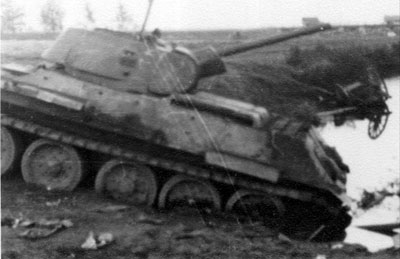 |
The workers housing area of this factory was also defended by remnants of the 138th Rifle Division, particularly its 768th Rifle Regiment.
Another hard fought for area was the chemical factory "Lazur" and its surrounding train yards, the so-called "tennis racket". The name was derived from the look of the railway tracks depicted from aerial photos. An amalgam of units from 284th Rifle Division, 9th and 38th Mechanized Rifle Brigades and other already shattered rifle and tank units defended this area stubbornly.
|
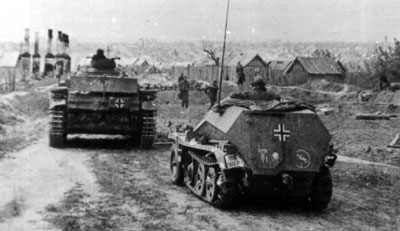 |
These remaining strongholds were connected by the thin defensive lines of the 161st Rifle Regiment and 95th Rifle Division (241st Rifle Regiment) in the south, and the 37th Guards Rifle Division (118th Rifle Regiment) in the north.
In between these more or less cohesive units a number of soldiers from various shattered units were mixed: 42nd Rifle Brigade, 347th Rifle Regiment, 685th Rifle Regiment, 895th Rifle Division, 45th Rifle Division to name but a few.
|
| The German 71., 76. , 79. , 94., 100. Jäger (Light), 305. and 389.
Infanterie divisions who, supported by other major units (14., 16. and
24. Panzer divisions), had been assaulting the city for weeks. Supported
by massive artillery, air and tank support, they were not able to sweep
the stubborn and fearless fighting Soviet defenders into the Volga and
thereby end the atrocious house-to-house fighting, which was taking a
bloody toll on both sides. |
|
The Germans especially were unable to start a last effort to take these few remaining strongholds, since most of their combat companies were so weakened. Many of them were down to about 50, some 30 or 40, rifle carrying soldiers. German commanders doubted if “these divisions should be used in such a manner at all”. The 14. and 24. Panzer divisions were particularly low in manpower. On 2 November at 1800 hours, Chief of Staff of 6th Army General Schmidt, reported that 79., 94. and 305. Infanterie divisions were no longer able to attack as whole cohesive units.
Some of these units were very low in strength, for example the 94. Infanteriedivision had a combat strength of only 535 men. The 6th Army ordered at this point to disband units, reduce the guns per battery to three, reduce the staff strengths, signal battalions and other support units to 10% of their manpower. Additionally Russian "Hilfswillige" (Hiwi or willing helper) should be increasingly employed in non-combat roles to free German personal for strengthening the decimated combat units.
Additionally as a last resort 10 battalions of Turkic soldiers from the Caucasus were to be sent to the Stalingrad area. This order from 6th Army high command was dated 6 November. All divisions would receive their Turkic battalions at the end of December.
|
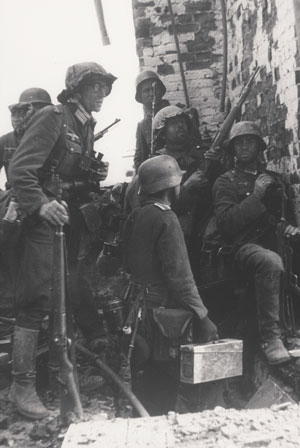 |
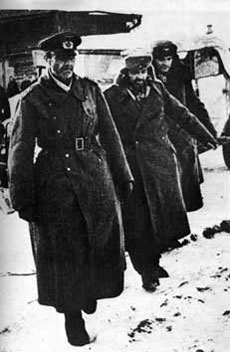 |
II. First Steps, First Plans
Hitler agreed on 2 November to send additional pioneer battalions to Stalingrad. The Chief of the German Army General Staff, Zeitzler, made this proposal, and Hitler probably envisioned an assault attack with small storm-trooper units, much like the German tactics at the end of WWI.
But Zeitzler was not the initiator of this idea. On 1 November Oberst-General Freiherr von Richthofen, commander-in-chief of Luftflotte 4 (Air Army), operating mainly over Stalingrad, contacted General Jeschonnek in Berlin and made a proposal. Richthofen recognized that the ongoing bombardments and close support missions of the VIII Fliegerkorps were taking their toll on machines and men alike. During a conference earlier the same day with von Paulus and Schmidt, he complained, that his air support was not fully utilized by the infantry units of 6th Army. Since he was not rebutted by Paulus, Richthofen was convinced his point was right. From this grew a deep mistrust between Richthofen and Paulus, especially from the former's point of view.
Zeitzler spoke with Hitler on 2 November during the daily conference and the latter agreed. Another proposal, to send the 29. Motorized Infanteriedivision into the city, was denied.
|
|
After Oberst I.G. (Oberst in the generals staff) Werner of 6th Army
heard this on the phone, he replied to the chief of staff of Army Group
B that reinforcement with some pioneers will not end the fighting,
since missing covering infantry was the problem.
Why pioneers and not a fresh infantry division? This question is very easily answered: The German pioneers were the masters of demolition, highly trained specialists in house-to-house fighting and the use of explosives. The regular Grenadier was not very versed in these areas and up to this point used tactics of bombardment-advance-close combat that led to horrible losses for the attacker. The Soviets in particular were the ruling masters of defence during this period of the war. Their ability to camouflage fortified positions, combined with an above average training in the use of the bayonet and excessive use of hand grenades, even at the risk of injuring their own comrades, allowed them time and time again to throw attackers back.
The Soviets, to some extent, had the psychological upper hand. The German Grenadiers did not have the same deep desire to repulse the fascist aggressors, further enhanced and cultivated by propaganda.
|
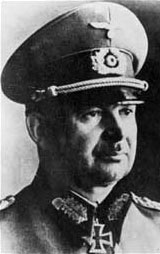 |
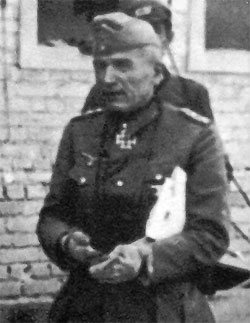 |
Together with the cruel handling of so-called deserters, cowards and
fascist collaborators, by the NKVD, the normal Red Army soldier had but
one choice: fight and maybe survive or don’t fight and die by the hands
of the NKVD. Stalin’s well known order of “No step back” reminded them
that their choices were very narrow.
The Pioneers on the other side had the special training in the above mentioned fields, which made them far better suited for taking the remaining, well fortified, positions from the brave Soviet defenders.
As for additional infantry divisions, there were none! The only probably possible infantry division, which would have been able to be transferred to the eastern front, the 334. Infanteriedivision, was just forming at Grafenwöhr, Germany. They were later transferred to Africa.
So General of Artillery von Seydlitz-Kurzbach, Commander of LI. Armeekorps proposed the following idea for the upcoming attack:
|
|
First attack to the Volga bank in the area of 295. Infanteriedivision,
then attack out of the metallurgic factory to the south. Another
proposal was to take the chemical factory “Lazur” itself (“if the
Führer orders”). The later was approved by the 6th Army high command.
On 3 November the 6th Army issued the order for LI. Armeekorps to first
attack the northern part of “Lazur”“ on 10 or 11 November.
At first LI. Armeekorps considered attacking the factories and the Volga bank with groups “Seydel” and “Scheele” simultaneously, and gave out order no. 109, dating 7 November. However, since even the most optimistic commander could see that this was to be a suicide mission, the Chief of Staff of the 6th Army and Chief of Staff of LI. Armeekorps conferred and a new attack plan was proposed (7 November 1215 hours).
So order no. 109 was revoked and the new corps order no. 110, dating 8 November 0400 hours, was issued. In this new order the seizure of the factory halls and Volga bend in the area of group “Schwerin” was not even mentioned.
|
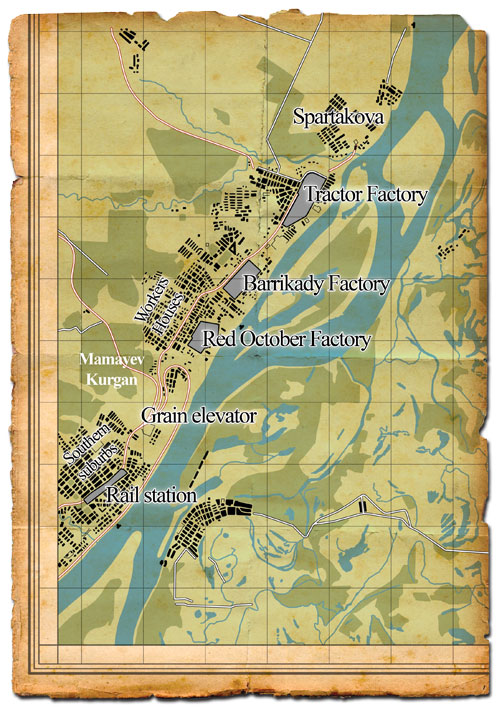 |
For that attack LI. Armeekorps had to regroup its forces. On 4 November they raised the group Schwerin, under the commander of 79. Infanteriedivision’s Major-General von Schwerin. It consisted of 79. Infanteriedivision and all infantry and infantry-like troops of 14. and 24. Panzer divisions. From the panzer divisions only the infantry, and comparable units like recon, Kradschützen (motorcycle infantry) and pioneers remained in the area. All other units were sent to the rear areas for regrouping and refitting. The artillery of these units was placed under command of artillery regiment 179. (Armeekorps order no. 105 dating 5 November).
|
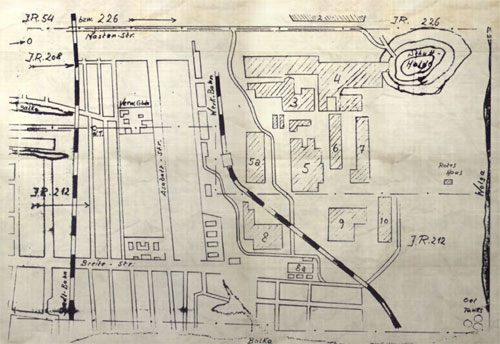 |
III. The final plan
On 5 November General von Sodenstern contacted AOK 6 (6th Army command) and asked if an attack against the eastern area of the metallurgic factory and the gun factory could be started. After von Paulus conferred with Army Group B, and then with Hitler, he ordered that the proposal should be set into action. Planning for the attack was coordinated between LI. Armeekorps and 6th Army and von Seydlitz-Kurzbach issued on 8 November his order to attack, codenamed Operation Hubertus.
|
|
As the proliferation of confusing orders, and especially attack objectives, of the upcoming operation were changed and changed again, Army Group B contacted 6th Army on the evening of 6 November and informed them “that the Führer has decided, that the bridgeheads north of the gun factory and the metallurgic factory should be taken first”.
The attack plan was finalised as the following: The whole area from the Volga bank east of gun factory “Red October” to the fuel depot to south east of the brickyard will be attacked with all available forces simultaneously.
In detail:
The 305. Infanteriedivision, reinforced by the pioneers, along with the reinforced 389. Infanteriedivision would attack with a lightning blow on the left flank and reach the Volga bank.
|
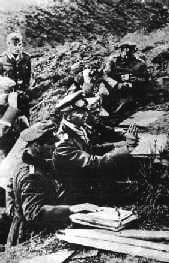 |
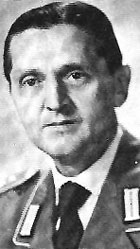 |
The 71., 295. Infanterie and 100. Jäger divisions together with group Schwerin were to undertake prepared assault attacks to confuse the enemy about the true nature of the offensive. Strong forces of VIII Air Corps should support the attack. After that first act the Volga bank east of “Lazur” should be taken, and finally the chemical factory “Lazur” itself.
The question arose, who should plan and execute the crucial part of the operation, the pioneer attack in the north of this last offensive? After long discussions between von Paulus, von Seydlitz-Kurzbach and Oberst Herbert Selle, commander of pioneers of 6th Army, the later proposed (an up to this point quiet man during the planning) one of his Pioneer officers, “an expert in his field.”
The man proposed for the task was Major Josef Linden, a 38-year old professional officer from Essen, commander of army Pionier Bataillon 672. His unit was mentioned in the Wehrmachtsbericht (armed forces report) after their grand bridge operations over the Dnieper and the clearing of large mine fields in front of the Stalingrad fortress lines. At Kalatsch he was building up the pioneer training school of the 6th Army.
|
|
Linden received the order from Oberst Selle on the evening of 6 November to report the next day at 0900 at liaison point X for a special mission. He left Pionier Bataillon 672 behind and 14 hours later he reported with his staff personnel at this point X, the so called “ring-binder”, the command post of 305. Infanteriedivision in Stalingrad North. The division’s Chief of Staff Oberst Steinmetz informed him of the special mission. He was to clear the remaining Soviet bridgeheads on the western bank of the Volga river: the ordnance factory “Red Barricade”, metallurgic chemical factory “Lazur”, the “tennis racket” (the train yards), the “White house” (chemist’s shop) and the “Red House” (Commissar’s house).
|
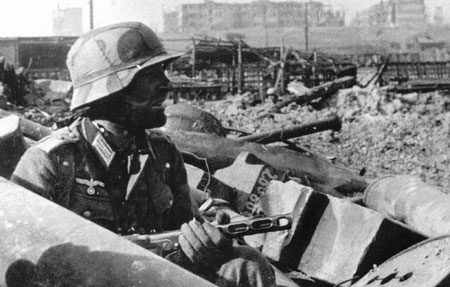 |
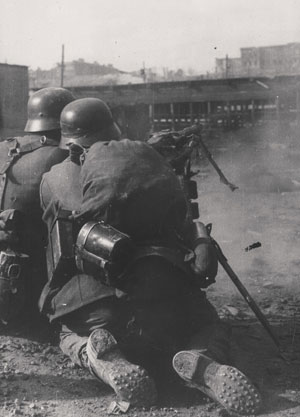 |
For this difficult task he was assigned the following troops as an assault force:
Pionier Bataillon 50 (mot), Hauptmann Gast, from 22. Panzerdivision
Pionier Bataillon 162, Major Krüger, from 62. Infanteriedivision
Pionier Bataillon 294, Hauptmann Weimann, from 294. Infanteriedivision
Pionier Bataillon 305, Hauptmann Traub, from 305. Infanteriedivision
Pionier Bataillon 336, Hauptmann Lund, from 336. Infanteriedivision
Furthermore Pionier Bataillons 41 and 45 (the later under Hauptmann Drewitz) were also assigned to Oberst Linden from Pionier Regiment Stab 604 (pioneer regimental staff).
Additionally he was to command Pionier Bataillon 389 under Hauptmann Pfitzner, which had already been fighting for several weeks in this area.
Oberst Selle estimated a mere 6 to 8 days duration for this final operation.
So on paper this made up for an impressive eight pioneer battalions. Numerically major Linden should have about 4800 assault pioneers at his command.
|
But the following points give another picture entirely:
1) Pioneer Battalion 50 (mot) contributed only 2 companies since their 3rd (panzer pioneer company 140) remained, along with their half-tracks, with the rest of 22. Panzerdivision. The unit was dispatched to the LI. Armeekorps about 2 weeks before the scheduled attack for street fighting, so after serious combat this unit was not at full strength.
2) Pionier Bataillons 305 and 389 had been already fighting for weeks in Stalingrad and they were down to more or less company sized battlegroups.
3) Pionier Bataillons 41 and 45 had also already suffered causalities, since they took part, alongside Pionier Bataillon 295 in the forced Don crossing earlier in the campaign. The 3rd company of Pioneer Battalion 45 was especially under-strength. They participated in the earlier fighting for the grain elevator and southern railway station, so the 3rd company was held back. Both battalions were combined into one battlegroup under Hauptmann Sprenger, designated Pionier Bataillon Sprenger.
4) Pionier Bataillon 162 was drawn from their positions behind the Italian 8th Army. They were just scheduled for a rest and refit phase. The exact strength can’t be verified, but the unit must certainly be considered less than “fresh”, although the last weeks before their front were relatively quiet.
|
Therefore the only relatively “fresh” units were Pionier Bataillons 294 and 336, but they, together with Pionier Bataillon 162, were several hundred miles away. Pionier Bataillon 294 was behind the Don bend, Pionier Bataillon 162 with the Italian 8th Army and Pionier Bataillon 336 with XXIV Armeekorps with the 2nd Hungarian Army near Voronezh.
Although the exact strengths of the transferred units can’t be verified 100%, available sources are not very specific here, one seems to be quite correct: According to the diary of general Oberst von Richthofen the strength of the battalions were as following (officers/NCOs/ranks):
Pioneer Battalion 45 9/30/246
Pioneer Battalion 50 (mot) 10/44/405
Pioneer Battalion 162 7/31/281
Pioneer Battalion 294 4/29/275
Pioneer Battalion 336 8/38/336
So they totalled only 1753 men. None of these units were at full strength.
|
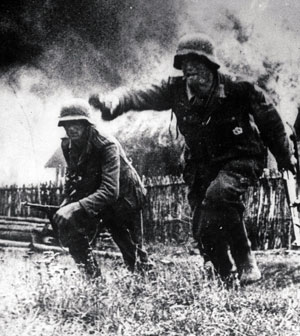 |
After the numbers became obvious, General Schmidt from 6th Army made a last plead to the Army Group on 3 November at 1100 hours demanding, in addition to the pioneers, that the infantry from 29. and 60. Motorised divisions be made available. He, like the rest of the commanding frontline officers, foresaw the problem of holding the newly gained ground with their depleted infantry units. Army Group B’s General von Sodenstern, denied this request since “it is not approved by the Führer”.
|
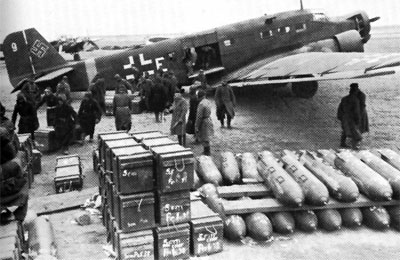 |
The greatest problem for bringing the units into
Stalingrad, was the bad road situation, combined with the always scarce
transport capacities.
After conferring with von Richthofen, major Linden was informed, that it would take about 3 days before this units would become available, because some of them had to be flown into the Stalingrad area to meet the time schedule for the attack. Again the train transportation capacity was so low, that only Pionier Bataillon 336 was considered to be sent to Stalingrad by train. After close examination of the available transport space, this unit also had to be flown in by air.
|
|
Additionally von Paulus, after realizing the
lack of infantry support and conferring with General-Leutnant von
Seydlitz-Kurzbach ordered, that 10 battle groups should be formed from
the 71., 79., 94., 100. Jäger, 295., 305., 389. Infanterie and 14. and 24. Panzer divisions, to back up the assaulting pioneers and take up the newly gained positions.
These battle groups, as far as can be ascertained, were formed as follows:
1) 14. Panzerdivision: Parts of Panzer Regiment 36, the half-track battalion, and Panzer Artillery Regiment 4 were withdrawn to Kotelnikowo. All non-mobile panzers, vehicles and weapons were transferred there. The Panzergrenadier regiments were ordered to stay at Stalingrad, holding their positions and they contributed a roughly oversized battalion combat group. Besides that the 14. Panzerdivision was ordered to build up a panzer company and artillery battalion as a mobile reserve. This group was designated “Kampfgruppe Seydel”. They had (without staff and the heavy company) a personal strength of 11/60/507.
Weapon strength: 43 light MG, 13 heavy MG, 5 mortars, 9 light infantry guns, 3x 3.7cm anti tank guns, 6x 5cm anti tank gun, 5x 7.5cm anti tank guns, 6 Panzer III long , 1 Panzer IV short.
|
|
2) 24. Panzerdivision: On 11 November Panzergrenadier Regiment 26 formed an assault company under Oberleutnant Beyersdorff. Additionally Kradschützen battalion 4 (KB 4) was reinforced with companies 3, 4 and 5 of the armoured recon battalion (Panzeraufklärungsabtielung, PzAA 24). Their strength was 3(34)/23(197)/98(953). The numbers in parentheses are the required strength! 1st and 2nd companies (armoured cars and half-tracks) of KB 4 were withdrawn to the great Don bend. They were attached to the 389. Infanteriedivision.
3) 24. Panzerdivision also formed "Kampfgruppe Scheele" with a total strength of 23/122/640.
4) The Croatian 369. Grenadier Regiment received a newly arrived battalion (4 November) and was boosted up to the strength of a reinforced battalion. They numbered a full infantry battalion (the arriving reinforcements) plus the remnants of the original regiment: 1 infantry company with 98 men and 8 light MG, 1 heavy MG company (73 men and 11 heavy MG) and 1 anti-tank company with 20 men and 6 guns.
|
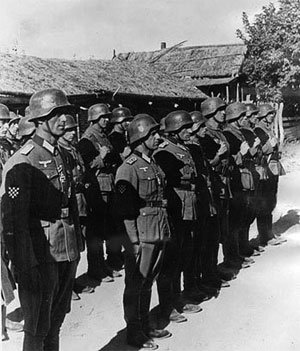 |
|
They were first attached to 212. Grenadier Regiment (79. ID, 6 November), then later to the 305. ID (11 November).
5) 79. Infanteriedivision withdrew its Pionier Bataillon 179 under Hauptmann Weltz and reinforced it with the following units: 1 heavy mortar detachment, 13./208., 13./212., 13./226. Grenadier Regiment (the light infantry gun companies of these regiments), 2 groups of Radfahrabteilung 179 (bicycle riders),1 platooon of 2cm Flak38 guns from 4./37., and 2 heavy infantry guns (sIG 33). On request they were allocated fire from I./Artillerie Regiment 179 (1st battalion artillery regiment 179). They were later to be attached to the 389. Infanteriedivision.
|
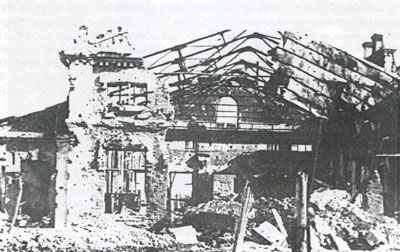 |
6) 79. Infanteriedivision also formed on 5 November, from its II Battalion, 212. Grenadier Regiment, Sturmkompanie 212. Strength: 3/28/146, weapons: 9 light MG, 2 heavy MG, 4 mortars, 2x 3.7cm Pak36 guns.
7) 79. Infanteriedivision also withdraws I./226. Grenadier Regiment out of the front line (6 November) and places it as reserve behind II./226. Grenadier Regiment. This enables them to form Sturmkompanie 226.
8) 94. Infanteriedivision withdrew parts of their 274. Grenadier Regiment along with Radfahrabteilung 194 (bicycle riders) and put it under command of Hauptmann Brendel. They were also attached to 389. Infanteriedivision.
|
9) Since 578. Grenadier Regiment (305. ID) was so badly mauled, its 2nd battalion for example only had 41 men left, Kampfgruppe 578 was formed, where all survivors of the regiment were concentrated. The commander was Hauptmann Rettenmaier. They were later reinforced with Pionier Bataillon 50 (mot).
10) The other regiments of 305. Infanteriedivision (576 and 577) also formed similar battlegroups, although they were reinforced with personnel from their service units.
|
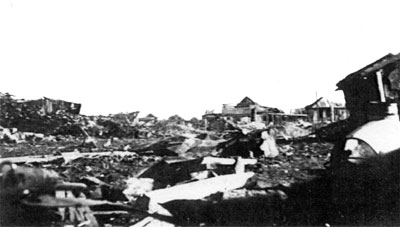 |
|
Before Major Linden planned his attack he took a look at the upcoming battlefield. His illusions about the operation, if he ever had them, were blown away. Through the Scherenfernrohr (periscope binoculars) and binoculars he saw a giant field of debris. The area was littered with rubble heaps of blown up walls, levelled buildings, loosely formed roofs of hanging steel plates, gigantic bombshells, piles of semi-finished gun barrels, bent steel supports, destroyed machines and electrical devices.
Where the ground was not open, he could only see craters and earth ploughed up by explosions. All of this unnameable chaos was bristling with bunkers, fortifications and trenches. A truly shocking sight, a “snake pit”, for every troop commander who feels responsible for his men. Behind all of this the ground smoothly sloped to the Volga, where it stopped on the eastern bank of the river. This bank would later prove impenetrable and from above it gave the viewer the impression that it was cut with a giant sword.
After his recon tour major Linden spoke with von Seydlitz-Kurzbach. He outlined that an offensive with his pioneer battalions split between the different assault units would spell doom upon the attacking soldiers. He convinced his superior commander that the pioneers should attack one enemy position after the other. Von Seydlitz-Kurzbach then split the planned operation in to two stages, “Schwerin I” and “Schwerin II”.
|
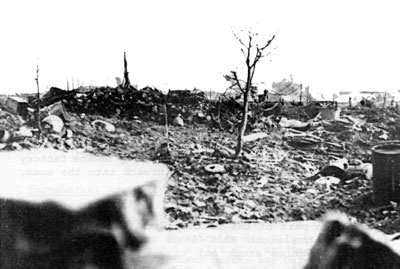 |
He planned to let the Group Schwerin assault force attack, with the to
be assigned pioneer battalions attacking from the north, on 13 November
between metallurgic factory and ordnance factory. On 20 November the
second attack was to take the ground from the fuel depot southeast to
the “Red October” factory and simultaneously destroy the enemy in the
Martin oven hall (no. 4) of “Red October”. For the second attack he
held whole of group Schwerin in reserve and it was not initially to be
committed for the opening phase of “Operation Hubertus”!
Part Two: Soviets and preparations (live Dec 3)...
|
Last Updated On Friday, November 27, 2009 by Wayne at Battlefront
|
|
|